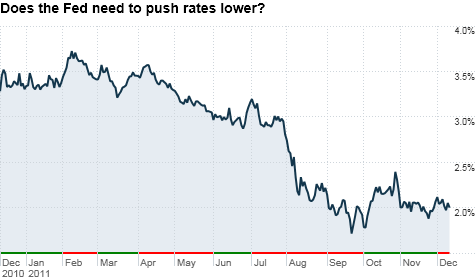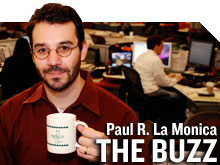Search News

With the benchmark 10-year Treasury already yielding just 2%, some think the Fed's only weapons left to keep rates low are words. Click chart for more on bonds.
NEW YORK (CNNMoney) -- The Federal Reserve has pretty much pulled out all the stops to try and keep the U.S. (and some would argue global) economy from collapsing.
Interest rates left near zero for three years? Check. Two big rounds of so-called quantitative easing, buying long-term Treasury bonds to push rates lower? Been there. Done that.

Selling short-term bonds to buy even more long-term Treasuries, or Operation Twist? Already taken care of. Flooding the financial markets with cheap dollars to keep European banks from a credit crunch? One step ahead of you.
At this point, there is little left for the Fed to do other than talk about how it should be talking about the markets and economy. The central bank's policy committee gets together Tuesday, and the only news of note that might come from the meeting are possible changes to the Fed's communications strategy.
Call it QY: Quantitative yakking.
According to the minutes of the Fed's last meeting in early November, policymakers discussed "potential approaches for enhancing the clarity of their public communications." That could include specific targets for inflation and more details about when the Fed may change interest rates.
Under chairman Ben Bernanke, the Fed has taken several steps to provide more clarity about its inner workings. Bernanke started giving press conferences this year in conjunction with the release of the central bank's latest economic forecasts.
The Fed also took the unprecedented step back in August of saying that it was likely to keep rates "exceptionally low" until the middle of 2013. Previously, the Fed had just said rates would be low for "an extended period."
But is it a scary sign that the Fed may want to open up even more to the investing public? What's next? Bernanke tweeting his thoughts on inflation? Janet Yellen putting how she plans to vote at Fed meetings as her Facebook status update?
Now don't get me wrong. Increased transparency is a good thing. As someone who's followed the Fed closely for the past 15 years, I can certainly say the central bank has come a long way in removing much of the shroud of mystery that surrounds it.
Still, the Fed could risk giving, in the parlance of texting, TMI. Should it really be giving out the secret sauce for when it will raise or lower interest rates or take other actions? The problem with telling someone you are going to do something is that you then must live up to your promise or risk losing credibility.
Of course, the Fed may be more willing to let people see what's behind the curtain to silence its many critics, including some powerful lawmakers who think the Fed has too much power.
But by doing so, there's also the concern that the more the Fed talks about the economy, rates and the markets, the greater chance there is that comments are blown out of proportion.
"Transparency may keep Congress off the Fed's back. But the Fed runs the risk of having their remarks misinterpreted," said Sharon Stark, managing director for fixed income with Sterne Agee in Birmingham, Ala.
What's more, the Fed may limit the effectiveness of any moves by painfully telegraphing them so far in advance. In fact, it could even harm the markets because it could encourage some Wall Street firms to make bad bets.
"A certain amount of communication is a good thing. But total transparency has created an environment of undue risk-taking on the part of financial institutions," said Steve Blitz, senior economist for ITG Investment Research in New York. "When everybody knows what the Fed is going to do, it allows the market to take bets to game that."
Along those lines, this market has also become so addicted to low rates that some are hoping the Fed will further push out the time for when it will start tightening again. Some strategists suggested the Fed could conceivably change the definition of "extended period" from mid-2013 to the start of 2014.
But what good would that do for average Americans? As I've written repeatedly in this column, low rates are nice but only part of the economic equation.
So what if the 10-year Treasury yield is near 2%? And if rates fell to 1.5% thanks to Fed jawboning? Would that make a difference? It doesn't matter if mortgage rates are cheap if consumers don't want to borrow and banks don't want to lend.
"The Fed can have power with its words. But what other benefits can you get from further Fed communication?" asked Keith Hembre, chief economist for Nuveen Asset Management in Minneapolis. "Once you talk about bringing interest rates down from already extremely low levels, are you likely to get much of an economic impact?"
There's also Europe to consider. If the Fed's main goal at this point is to keep long-term Treasury rates low, it's getting a lot of help from our friends across the pond. As long as the U.S. looks good in comparison to Europe, investors are likely to keep buying U.S. bonds no matter what the Fed does.
"I'm not sure what the Fed can do or needs to be done at this point," Blitz said. "It needs to wait for a sense of resolution in Europe before taking more action, if any action."
In other words, the Fed should resist the urge to keep talking about what it will or won't do. It cannot and should not show the markets every card in its hand.
Best of StockTwits: Intel's (INTC, Fortune 500) revenue warning, a sell-off in gold and more nutty goings-on at Diamond Foods (DMND) were the talk of the town with our pals on StockTwits.
mytfine: Deutsche Bank first out defending $INTC, will be first of many. Must protect this house!!
Ha. Love the Under Armour (UA) reference. But you called it. Looks like JPMorgan is also trying to explain away the warning is temporary ... which brings me to the next tweet.
Bjedz: The component explanation by$INTC although true is just an excuse to explain slowing global growth.
Exactly. I wrote on Friday about a possible "geek-cession." Several chip companies have warned lately about slowing consumer demand. That has nothing do with the flooding in Thailand and resulting disk drive shortage.
StockSage1: Liquidity is not "inflationary" or necessarily a positive for precious metals...austere fiscal programs = large negative $GLD
Great point. Gold has been considered a fear trade/alternative currency/inflation hedge. But fundamentals still matter. Reduced demand for gold as a result of a global economic slowdown should lead to lower prices.
Finally, a little context about Diamond before the last tweet.
The Emerald Nuts maker's stock has been hit hard due to questions about its books. But Diamond surged more than 50% Friday after a KeyBanc analyst wrote that an accounting probe may soon end and that Diamond's plan to buy the Pringles brand from Procter & Gamble (PG, Fortune 500) should stay on course.
Adamantium: And what happens if $DMND delays their earnings report tomorrow cause the auditors won't sign off?
You nailed it. That tweet came at shortly after midnight today ...before Diamond delayed its 10-Q filing. The accounting worries are far from over. The Pringles purchase is clearly not a done deal. And Diamond's stock fell 25% Monday.
The opinions expressed in this commentary are solely those of Paul R. La Monica. Other than Time Warner, the parent of CNNMoney, and Abbott Laboratories, La Monica does not own positions in any individual stocks. ![]()
| Index | Last | Change | % Change |
|---|---|---|---|
| Dow | 32,627.97 | -234.33 | -0.71% |
| Nasdaq | 13,215.24 | 99.07 | 0.76% |
| S&P 500 | 3,913.10 | -2.36 | -0.06% |
| Treasuries | 1.73 | 0.00 | 0.12% |
| Company | Price | Change | % Change |
|---|---|---|---|
| Ford Motor Co | 8.29 | 0.05 | 0.61% |
| Advanced Micro Devic... | 54.59 | 0.70 | 1.30% |
| Cisco Systems Inc | 47.49 | -2.44 | -4.89% |
| General Electric Co | 13.00 | -0.16 | -1.22% |
| Kraft Heinz Co | 27.84 | -2.20 | -7.32% |
| Overnight Avg Rate | Latest | Change | Last Week |
|---|---|---|---|
| 30 yr fixed | 3.80% | 3.88% | |
| 15 yr fixed | 3.20% | 3.23% | |
| 5/1 ARM | 3.84% | 3.88% | |
| 30 yr refi | 3.82% | 3.93% | |
| 15 yr refi | 3.20% | 3.23% |
Today's featured rates: